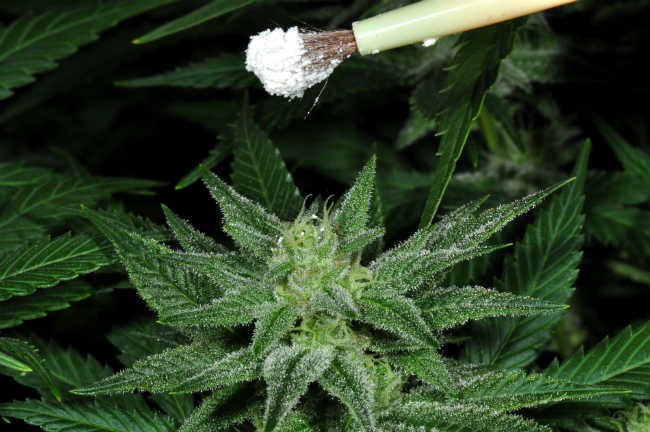THC, the psychoactive component that gives consumers an uplifting high, is constantly higher in today’s marijuana. A higher ability to grow may be the fundamental explanation for the explosion of strong cannabis strains.
Cannabis breeders often aim to purify and strengthen strains, mix strain traits, or improve certain attributes like better yields, specific fragrances, potency, and a variety of other qualities.
Some strains thrive in an indoor setting, while others thrive in the great outdoors. Indoor growers prefer short, sturdy plants since they take up less room, which is limited. It’s crucial to know where your seeds come from and what kind of genetics they have when growing and breeding.
Why Would You Want to Cross-breed Cannabis?
Table of Contents
What exactly is the big deal about cross-breeding cannabis? To begin with, breeding cannabis allows a home producer access to new hybrid genetics while also serving as a conservation mechanism, preserving (and even strengthening) preferred genetics for future usage ().
Those who want to keep their seed stock going into the next season will discover that breeding is a viable option for doing so.
Breeding on a medium to big scale is both straightforward and successful if you have unique strains and generate hybrids.
Cannabis Ruderalis
A prime example of how cross-breeding has changed the world of marijuana is the case of the Cannabis Ruderalis plant (). Ruderalis, unlike Sativa and Indica cannabis cultivars, can self-flower. To put it another way, it does not rely on light to generate blossoms. Instead, the plant begins to produce flowers and buds after reaching maturity.
Ruderalis plants usually flower between the ages of 21 and 30 days. After germination, ruderalis plants can yield ready-to-harvest buds in as little as 70 days.
Autoflowering Trait
The autoflowering strains of cannabis would not exist without the careful cross-breeding of the ruderalis with other, more potent strains. Provide a whole array of benefits when added to the genetic makeup of any other strain.
Most autoflowering variants have inherited the ruderalis species’ tenacious qualities due to their genetic heritage. This implies they’re adept at dealing with extreme cold, as well as common garden pests, diseases, and infections.
In as little as 70 days, autoflowering cannabis plants can be harvested (). In contrast to common strain. These plants take extremely little time to mature thanks to their ruderalis genetics, after which you’ll get your hands on some luscious, sticky buds.
Autoflowering cannabis strains allow gardeners to generate more harvest each year than standard photoperiod strains due to their quick flowering times. This is particularly beneficial for outdoor producers, particularly in colder climates with shorter summers.
Consistency in Strains
Lab testing will establish that different strains have different quantities of cannabinoids, terpenoids, and flavonoids. What you may not realize is that the same strain comes in various forms.
Most cannabis users have discovered a strain they prefer, but they are frequently surprised by the strain’s lack of consistency. This is due to several factors. First, the growth environment and practices and lighting will have an impact on the final result. However, the true cause of the inconsistency is cannabis genetics and breeding.
Why Is There So Much Variation Among Strains?
The cannabis plant is dioecious, meaning it has male and female plants, with the female being the one grown for its THC-rich flowers (). Because you must pollinate a female plant with a male plant, breeding dioecious plants is more difficult. Seeds produced by cross-pollination between two plants have more genetic diversity than seeds produced by self-pollination.
Cross Breeding Cannabis Plants
A male and many females are placed in a breeding chamber to retain the pollen once two parent strains have been chosen for breeding. A breeding chamber can be as simple as an enclosed environment with plastic sheeting on the sides or as complex as a specially designed sterile environment for mass breeding.
Selecting parent strains with the best traits is the first step in cross-breeding. The next step is to cross-breed them until they achieve the ideal blend of both parent plants. Unfortunately, it is not something you can get right the first time. Indeed, mastering the cross-breeding technique will likely take several generations of plants and several years.
Things to Keep in Mind When Cross-breeding
Keep in mind that each marijuana plant is unique. When you grow seed from a seed, the seedlings will inherit qualities from both parents. You might end up with some strange, one-of-a-kind, and spectacular new strains in the end. The first stage is always to have good genetics. Therefore here are some traits to look for when selecting strains for breeding:
-
Buds: Consider the amount of THC or CBD in a plant, as well as its overall potency, color, fragrance, aesthetics, and effects. The problem is that when you concentrate on one quality, you overlook others. If you’re concentrated on attaining a purple color, for example, you’re not paying attention to how the plant impacts you.
-
Growing patterns: Is it bushy and short or tall and lean? How long does the blossoming period last? What type of return can you anticipate? To do so, keep an eye on the plant as it grows.
-
Durability: What is the rate of growth of the plants? Is it very mold and pest resistant? Do the stems have a lot of strength? How does it cope with extremes of temperature?
The Process
The first stage is to decide which plants will be female and which will be male. Simply cultivate your weed as usual to choose a female, and if a female plant has good fat buds, grows well, and is otherwise healthy, keep it.
Finding perfect male plants is more difficult. The only way that has been demonstrated is ‘trial and error.’ To begin, cross a male plant with various females to see what kind of progeny they create. You’ll eventually identify a male plant with desirable features for the offspring.
Keep the male and female plants separate during the growing phase once you have them. Men and females should always be separated as soon as the little pollen sacs on males (their pre-flowers) appear.
What Is a Phenotype?
A phenotype is a combination of a plant’s genetics and its environment, and it’s a list of characteristics that you can see in a plant. You might have a strain with a short phenotype, for example. They are similar to the characteristics that children inherit from their parents, and each child has a unique phenotype. If both of your parents are tall, for example, you are likely to be tall as well. You could be tall or short, and your siblings could be substantially taller or shorter than you if you have one short and one tall parent.
Homozygosity and Heterozygosity
Heterozygous refers to a plant that develops a large number of different phenotypes. When it comes to cannabis, homozygous seeds—those with an identical set of genes—are preferred. Homozygosity guarantees that a plant will consistently generate the same seeds with the same genetic composition, ensuring that purchasers and customers receive the same plant or seed every time.
After a strain has been crossed, a breeder must decide which phenotype of the new strain they prefer. For large-scale producers, the optimal genotype for mass production is important.
Backcrossing
When it comes to high-quality breeding, it doesn’t end there. After a breeder has crossed a strain and narrowed down a phenotypic till they’ve found the one, they’ll usually backcross it to improve its genetics.
Backcrossing is the technique of a breeder cross-pollinating a new strain with itself or a parent, thereby inbreeding it. This makes the strain more homozygous, which improves its genetics and desirable traits while also ensuring that the genes are passed down from generation to generation.
This inbreeding aids in producing offspring who are genetically identical to the chosen parent. As a result, every backcrossed progeny plant will certainly have two copies of the chosen parent’s genes.
In Short
Hopefully, you now have a better understanding of cross-breeding and its potential effects. The first stage is to decide which plants will be female and which will be male. Simply cultivate your weed as usual to choose a female, and if a female plant has good fat buds, grows well, and is otherwise healthy, keep it.
Finding perfect male plants is more difficult. The only way that has been demonstrated is ‘trial and error.’ To begin, cross a male plant with various females to see what kind of progeny they create. You’ll eventually identify a male plant with desirable features for the offspring.
Keep the male and female plants isolated during the growing phase once you have them. Men and females should always be separated as soon as the little pollen sacs of males (the pre-flowers) appear. Otherwise, the males may pollinate the females, resulting in unknown genetics.
To start, you will need good seeds. We recommend i49. Their extensive collection of seeds and well-cataloged seed banks is a blessing to new and veteran growers and breeders. With the help of quality seeds, you can breed your perfect strain.

